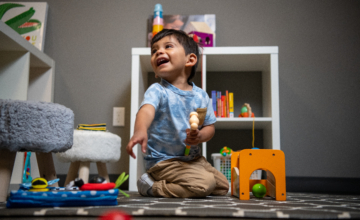As babies grow, they learn to use their bodies to make discoveries. Find out what your baby is learning as they play with you, and activities you can do to support their development!
Babies learn largely through their senses: Their eyes, ears, nose, hands, and mouth are their tools. As babies grow, they learn to use their bodies to make discoveries. They begin to reach and grasp (watch out for long hair), which allow them to explore toys in new ways.
At around 9 months, babies are getting better at understanding cause and effect: “I push the button to make the music play.” They are also starting to understand that the things they can’t see still exist. This means a child will look for the ball that rolled behind the couch and call for you when you leave the room. As babies approach their first birthday, they will be good communicators, using their gestures, facial expressions, sounds, and maybe even some “words” (such as “duh” for “dog”).
Games To Play
| Back and Forth | Coo and talk to the babies in your care. Imitate their sounds and wait for their response. Encourage them to copy you, too. Show them how to push the button to the toy dog bark or how they can turn the pages of a book. |
| Peek-a-Boo | Try hiding behind your hands, a diaper, or a onesie as you dress a baby. Early on, he may show his pleasure simply by watching closely. Then he may smile, kick, and make sounds. By 9 months, he may pull you r hands away to “find” you. |
| Sing and Dance | Listen to different kinds of music and dance in different ways to see what your babies like best. Ask the children’s parents what music they enjoy and if there are special songs from their family or culture they’d like to share. |
| Play Ball | Offer a ball with different colors and textures. Let babies explore it with all of their senses. Eventually they will learn to roll it, drop it in a box, and take it out again. |
What They’re Learning
This example shows how even during simple play times, babies are learning so much from you.
Marsha is playing with 4-month-old, Jared, who loves his rattle. “Let’s watch it fly,” Marsha suggests. She moves the rattle through the air so Jared can see it. Jared’s little arms and legs go like egg beaters! When Marsha hands the toy to Jared, he grabs it and begins to chew. Jared then shakes the rattle and delights in the soft, tinkling noise. Soon, Jared gets tired and turns his head away. Marsha takes the rattle and continues to shake it in front of Jared’s face. Jared closes his eyes and begins to wail. “Okay, I get it. Time for a break,” says Marsha. She picks up Jared and cuddles him.
During this playtime with his caregiver, Marsha, Jared learns about:
- Sounds of words and the rhythm of language as Marsha talks with him.
- Communication as he and Marsha engage in a back-and-forth “conversation.”
- His own self-worth as he sees the pleasure his caregiver gets from playing with him.
- Imitation and cause and effect when he shakes the rattle like Marsha does and hears the noise.
- Hand–eye coordination as he reaches and grasps the rattle.
- Objects when he hears the rattle’s sounds, sees its colors, feels its texture, and even smells and tastes it.
- Hand–eye coordination as he reaches and grasps the rattle.
- Objects when he hears the rattle’s sounds, sees its colors, feels its texture, and even smells and tastes it.




